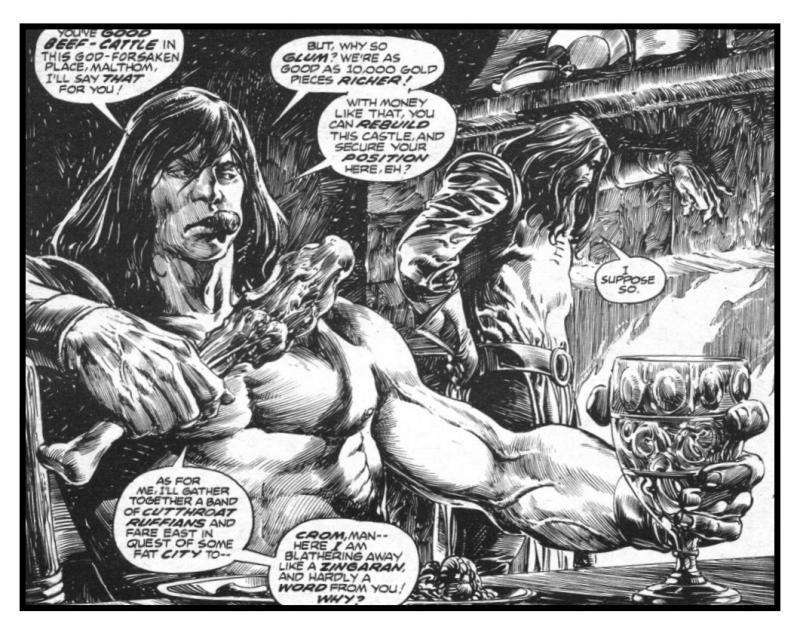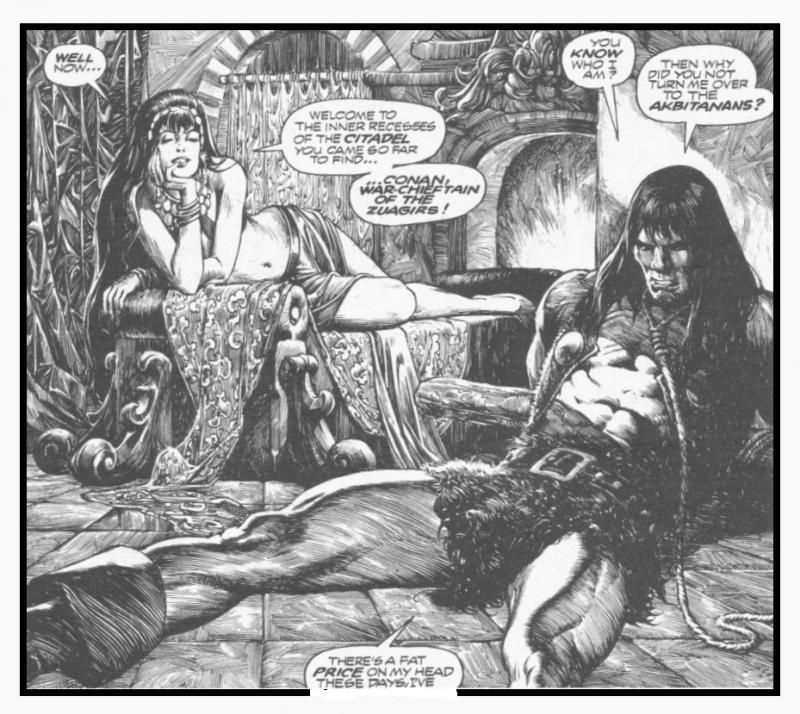Confessor
CCF Mod Squad
Not Bucky O'Hare!
Posts: 10,212 
|
Post by Confessor on May 13, 2017 3:11:46 GMT -5
Here's a question - Was there any time that a Tom Palmer collaboration looked bad? No. Anyone with any sense knows that everything is better with added Tom Palmer.  |
|
|
|
Post by Phil Maurice on May 13, 2017 8:15:07 GMT -5
Undeniably. And your explanation makes perfect sense. Thanks! |
|
|
|
Post by kirby101 on May 13, 2017 8:24:02 GMT -5
Here's a question - Was there any time that a Tom Palmer collaboration looked bad? Or a Joe Sinnott? I remember an issue of the X-Men that Don Heck drew and Palmer inked. Never cared for Heck, but Palmer made him look good.  Can't think of bad art with Sinnott inking either. |
|
|
|
Post by kirby101 on May 13, 2017 8:28:25 GMT -5
By the time Silver Age Superheroes were here, it was mostly different people doing each. So you posit that the publishing model (Superheroes) drove the separation of labor? That's interesting. I hadn't considered that. Not sure, and it is a good question to ask any of those artist that are still around (very few). It may be the publishing model of Superheroes, or it just coincided with the Silver Age. |
|
|
|
Post by kirby101 on May 13, 2017 8:36:42 GMT -5
So here's a question for the board's scholars. Maybe my premise is flawed, but as near as I can tell, many (most?) Golden Age artists penciled AND inked their own work. When and why did the specialization and separation of those duties occur? I can see that a sort of assembly-line approach would be more efficient, but I imagine there must have been resistance from artists who were used to seeing a job through to the end. Or maybe not. I'm truly ignorant when it comes to this topic. Did it evolve organically or did some visionary publisher see the economic advantage of this practice? Most Golden Age artists did *not* ink their own pencils. You had to be a top talent like Lou Fine, Jack Burnley, or Bill Everett for a publisher or packaging service to even consider it, and even they often had others penciling their backgrounds and inking secondary figures. If you were a lesser talent or were learning on the job, you worked from layouts by their studio's art director (somebody with a strong sense of visual storytelling like Jack Binder or Will Eisner) or were assigned a specific task--backgrounds, airplanes, sound effects lettering--and that's all you did, working on whatever page was set on your drawing table.It was quite literally an assembly line; production was everything in those days. Creativity and originality were beside the point. You were fast or you were unemployed, period. Cei-U! Hope that's helpful! Thanks Cei-U. But the top talent did ink themselves. Especially in the 50s. I am thinking of the EC books, where the artists mostly inked themselves or collaborated with others in different ways sharing the work. Maybe it was the move from the studio model in the 40s to the freelance model of the 60s that drove this. I believe an exception was Ditko, who inked most of his own art for Marvel. |
|
|
|
Post by MDG on May 13, 2017 9:32:34 GMT -5
Most Golden Age artists did *not* ink their own pencils. You had to be a top talent like Lou Fine, Jack Burnley, or Bill Everett for a publisher or packaging service to even consider it, and even they often had others penciling their backgrounds and inking secondary figures. If you were a lesser talent or were learning on the job, you worked from layouts by their studio's art director (somebody with a strong sense of visual storytelling like Jack Binder or Will Eisner) or were assigned a specific task--backgrounds, airplanes, sound effects lettering--and that's all you did, working on whatever page was set on your drawing table.It was quite literally an assembly line; production was everything in those days. Creativity and originality were beside the point. You were fast or you were unemployed, period. Cei-U! Hope that's helpful! I read an interview with (I think) Jack Binder where he talked about a rubber stamp on the back of art boards with a list like: Script Layouts Main figure pencils secondary figure pencils Letters Main figure inks Secondary figure inks Background inks Pages would get passed from drawing table to drawing table and people would initial next to what they did, at a dollar per page. One reason the penciller/inker roles were more "solidified" in the Silver Age may have been that stories were getting longer and rather than having just 6-8 pages per book, as in atom age genre comics, an artist was responsible for 15-20 pages. Also, it was more valuable for publishers to have a good storyteller like Kirby or Infantino on as many books as possible. Ditko's an anomaly--but then he always is. |
|
|
|
Post by Rob Allen on May 13, 2017 19:03:47 GMT -5
Keep in mind that a lot of artists had uncredited assistants working for them, or helped out their friends who had a deadline crunch.
Examples:
Mike Esposito was in a deadline crunch and borrowed an assistant from Wally Wood. Mike was impressed by the kid's talent and sent him to Sol Brodsky to start getting some credited work of his own. The kid was Tom Palmer.
As I think I mentioned on this board recently, Mike Esposito and Joe Giella would often help their deadline-plagued friend Frank Giacoia.
He was never credited, but Marvel production artist Tony Mortellaro generally inked the backgrounds in Spider-Man in the Romita era, and maybe into Kane and Andru. He liked to put in half-obscured signs or billboards that, if you could see the whole thing, would say "Backgrounds by Mortellaro"
If a 1950s story is signed "Dick Ayers", that means Dick did it all himself. If it's signed just "Ayers", Dick laid it out and his assistant (and cousin) Ernie Bache finished it.
A lot of artists were paid but uncredited assistants at the beginning of their careers. Wally Wood's many assistants included Dan Adkins and Wayne Howard along with Tom Palmer. John Verpoorten assisted Tom Gill on the Lone Ranger comics. Mike Royer assisted Russ Manning. Mike Ploog assisted Will Eisner.
So even a straightforward pencilling or inking credit doesn't tell you the whole story.
PS: I see that the thread title has "penciler" spelled with one "l". A few years ago I instigated a long discussion on the GCD list about whether "penciler" or "penciller" was correct, or at least preferred. I think they went with two "l"s. What does the CCF think?
|
|
|
|
Post by Cei-U! on May 13, 2017 19:32:01 GMT -5
TwoMorrows' house style is one 'l' so that's what I go with these days, even though I personally prefer two.
Cei-U!
I summon the inner conflict!
|
|
|
|
Post by Slam_Bradley on May 13, 2017 19:50:44 GMT -5
I prefer one "l". I find myself trying to figure out how to pronounce it like the two l's in llama when I see penciller.
|
|
|
|
Post by Deleted on May 13, 2017 20:35:28 GMT -5
It's amazing how much some of you guys know!!
|
|
bran
Full Member
Posts: 227 
|
Post by bran on May 14, 2017 9:31:05 GMT -5
Buscema/Buscema - excellent Alcala/Alcala - excellent Buscema/Alcala - sick    |
|
|
|
Post by codystarbuck on May 14, 2017 9:52:39 GMT -5
Howard Chayin was an assistant to Gil Kane and Larry Hama also worked with Wally Wood. A lot of Woods guys overlapped with the Crusty Bunker folks, at Continuity.
|
|
shaxper
CCF Site Custodian
Posts: 22,874
|
Post by shaxper on May 14, 2017 10:16:37 GMT -5
Don Newton and Alfredo Alcala, with Adrienne Roy on colors. Batman never looked better.
|
|
|
|
Post by berkley on May 14, 2017 19:32:31 GMT -5
I prefer one "l". I find myself trying to figure out how to pronounce it like the two l's in llama when I see penciller. I feel like the two l's make it clear that the preceding i is a short vowel. But I don't know what the dictionary spelling would be. |
|
|
|
Post by Deleted on May 14, 2017 20:16:17 GMT -5
Some teams I pulled from some of my fave runs would be:
Jim Lee and Scott Williams
Tony Harris and Wade Von Grawbadger
Darryl Banks and Romeo Tanghal
Howard Porter and John Dell III
|
|